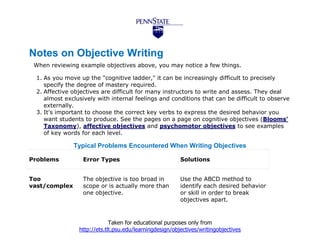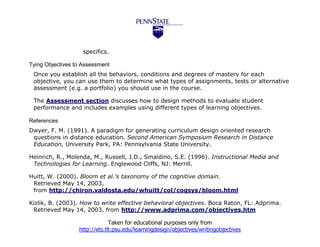The best choice for writing objectives
- 1. The Best Choice .... according to the experts Jones, 1997 – "Clear objectives can help the instructor design lessons that will be easier for the student tocomprehend and the teacher to evaluate". Lohr, no date – "A properly written objective tells you what specific knowledge, skill, or attitude is desired and what method of instruction and criteria for learner achievement are required." Rationale Writing clear course objectives is important because:  Objectives define what you will have the students do.  Objectives provide a link between expectations, teaching and grading. Basic Information Questions you need to think about  Who are your students? Freshman? Senior? A mix of different prior knowledge and experience?  Is this course a general education course or a course required for the major? Taken for educational purposes only from http://ets.tlt.psu.edu/learningdesign/objectives/writingobjectives
- 2. The A.B.C.D. method The ABCD method of writing objectives is an excellent starting point for writing objectives (Heinich, et al., 1996). In this system, "A" is for audience, "B" is for behavior, "C" for conditions and "D" for degree of mastery needed. 1. Audience – Who? Who are your learners? 2. Behavior – What? What do you expect them to be able to do? This should be an overt, observable behavior, even if the actual behavior is covert or mental in nature. If you can't see it, hear it, touch it, taste it, or smell it, you can't be sure your audience really learned it. 3. Condition – How? Under what circumstances or context will the learning occur? What will the student be given or already be expected to know to accomplish the learning? 4. Degree – How much? How much will be accomplished, how well will the behavior need to be performed, and to what level? Do you want total mastery (100%), do you want them to respond correctly 80% of the time, etc. A common (and totally non- scientific) setting is 80% of the time. Examples of Well-Written Objectives Below are some example objectives which include Audience (A), Behavior (B), Condition (C), and Degree of Mastery (D).Note that many objectives actually put the condition first. Taken for educational purposes only from http://ets.tlt.psu.edu/learningdesign/objectives/writingobjectives
- 3. Psychomotor - "Given a standard balance beam raised to a standard height, the student (attired in standard balance beam usage attire) will be able to walk the entire length of the balance beam (from one end to the other) steadily, without falling off, and within a six second time span." Cognitive (comprehension level) -"Given examples and non-examples of constructivist activities in a college classroom, the student will be able to accurately identify the constructivist examples and explain why each example is or isn't a constructivist activity in 20 words or less." Cognitive (application level) -"Given a sentence written in the past or present tense, the student will be able to re-write the sentence in future tense with no errors in tense or tense contradiction (i.e., I will see her yesterday.)." Cognitive (problem solving/synthesis level) -"Given two cartoon characters of the student's choice, the student will be able to list five major personality traits of each of the two characters, combine these traits (either by melding traits together, multiplying together complimentary traits, or negating opposing traits) into a composite character, and develop a short (no more than 20 frames) storyboard for a cartoon that illustrates three to five of the major personality traits of the composite character." Affective - "Given the opportunity to work in a team with several people of different races, the student will demonstrate an positive increase in attitude towards non- discrimination of race, as measured by a checklist utilized/completed by non-team members." Taken for educational purposes only from http://ets.tlt.psu.edu/learningdesign/objectives/writingobjectives
- 4. Notes on Objective Writing When reviewing example objectives above, you may notice a few things. 1. As you move up the "cognitive ladder," it can be increasingly difficult to precisely specify the degree of mastery required. 2. Affective objectives are difficult for many instructors to write and assess. They deal almost exclusively with internal feelings and conditions that can be difficult to observe externally. 3. It's important to choose the correct key verbs to express the desired behavior you want students to produce. See the pages on a page on cognitive objectives (Blooms' Taxonomy), affective objectives and psychomotor objectives to see examples of key words for each level. Typical Problems Encountered When Writing Objectives Problems Error Types Solutions Too The objective is too broad in Use the ABCD method to vast/complex scope or is actually more than identify each desired behavior one objective. or skill in order to break objectives apart. Taken for educational purposes only from http://ets.tlt.psu.edu/learningdesign/objectives/writingobjectives
- 5. No behavior to No true overt, observable Determine what actions a evaluate performance listed. Many student should demonstrate objectives using verbs like in order for you to know of "comprehend" or "understand" the material has been may not include behaviors to learned. observe. Only topics are Describes instruction, not Determine how students listed conditions. That is, the should use the information instructor may list the topic but presented. Should it be not how he or she expects the memorized? Used as students to use the information. background knowledge? Applied in a later project? What skills will students need? Vague The objective does not list the Determine parameters for Assignment correct behavior, condition, your assignments and specify Outcomes and/or degree, or they are them for your students. missing. Students may not sure of how to complete assignments because they are lacking Taken for educational purposes only from http://ets.tlt.psu.edu/learningdesign/objectives/writingobjectives
- 6. specifics. Tying Objectives to Assessment Once you establish all the behaviors, conditions and degrees of mastery for each objective, you can use them to determine what types of assignments, tests or alternative assessment (e.g. a portfolio) you should use in the course. The Assessment section discusses how to design methods to evaluate student performance and includes examples using different types of learning objectives. References Dwyer, F. M. (1991). A paradigm for generating curriculum design oriented research questions in distance education. Second American Symposium Research in Distance Education, University Park, PA: Pennsylvania State University. Heinrich, R., Molenda, M., Russell, J.D., Smaldino, S.E. (1996). Instructional Media and Technologies for Learning. Englewood Cliffs, NJ: Merrill. Huitt, W. (2000). Bloom et al.'s taxonomy of the cognitive domain. Retrieved May 14, 2003, from http://chiron.valdosta.edu/whuitt/col/cogsys/bloom.html Kizlik, B. (2003). How to write effective behavioral objectives. Boca Raton, FL: Adprima. Retrieved May 14, 2003, from http://www.adprima.com/objectives.htm Taken for educational purposes only from http://ets.tlt.psu.edu/learningdesign/objectives/writingobjectives
- 7. Lohr, L (no date). Objectives, sequencing, strategies. Retrieved May 14, 2003 from http://www.coe.unco.edu/LindaLohr/home/et502_cbt/Unit3/Unit3_menu .htm SOGC Org (No date). Writing instructional objectives: The what, why how and when. Retrieved May 14, 2003, from http://www.sogc.org/conferences/pdfs/instructionalObj.PDF Additional Links ï‚· Writing Objectives (B. O'Bannon, University of Tennessee) ï‚· Behavioral Objectives and How to Write Them (Florida State University) ï‚· Writing Objectives (Uniformed Services University of the Health Sciences) Taken for educational purposes only from http://ets.tlt.psu.edu/learningdesign/objectives/writingobjectives







